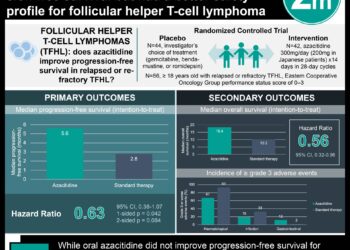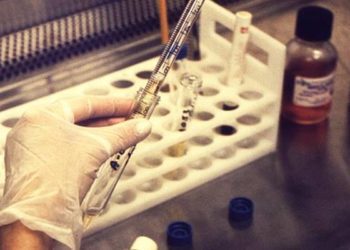Topical hypericin photodynamic therapy is effective and safe in early-stage T cell lymphoma
1. Hypericin photodynamic therapy was found to be more efficacious in treating early-stage T cell lymphoma lesions compared to placebo.
2. Common adverse events include mild skin and application site reactions; no serious adverse reactions occurred.
Level of Evidence Rating: 1 (Excellent)
Study Rundown: Mycosis fungoides is a rare T-cell lymphoma characterized by patches and plaques of T cells on the skin surface which can progress to aggressive tumors and extradermoid manifestations in later stages. Treating these cancers without causing damage to the underlying skin is challenging. Hypericin is a tumoricidal drug derived from plant sources which has demonstrated promise in early trials, although it has been associated with significant phototoxicity. To combat this, a new formulation of hypericin photodynamic therapy (PDT) has been developed. This randomized controlled trial reports on the efficacy and safety of hypericin PDT in treating early-stage, cutaneous T-cell lymphoma.
166 patients were included from 39 study sites in the United States. 116 participants were randomized to the hypericin PDT group and 50 to the placebo group in a 2:1 fashion. The hypericin PDT group had a significantly greater response rate than the placebo group after one cycle of therapy. Additionally, the response rate increased with the number of cycles of hypericin PDT treatment completed. Analysis of all patients who had received hypericin PDT at any point in the trial (including those who received placebo for cycle 2 alone) revealed that the response rate after 6 weeks of active treatment was 18% and 40% after 12 weeks. 15 patients achieved complete tumor response by the trial end point. 70% of patients reported at least one adverse event related to trial participation; skin reactions, pruritus and application-site irritation were more common in the hypericin PDT group than the placebo group. No serious adverse events related to hypericin PDT treatment were reported in this trial.
This double-blinded randomized controlled trial concluded that hypericin PDT is a relatively safe and efficacious treatment option for early-stage T-cell lymphoma. These findings are strengthened by the randomized trial design which does well to control for confounding. A primary limitation of this study was the short treatment course and follow up period such that long term side effects or potential cancer recurrence were not reported upon. Future study should seek to describe characteristics which may predispose patients to a fulsome treatment response, as well as assessing the clinical utility and feasibility of this therapy in a real-world setting.
Click here to read this study in JAMA Dermatology
Relevant reading: Cutaneous T cell lymphoma
In Depth [randomized controlled trial]: This phase 3, placebo-controlled, randomized controlled trial was titled the FLASH study. Adults with stage IA-IIA cutaneous T-cell lymphoma with at least 3 evaluable lesions were included. Patients underwent three, 6-week cycles receiving treatment twice a week. The trial was designed such that all patients would have the opportunity to receive the study drug by performing a crossover in cycle 2 and leaving cycle 3 as optional. Patients were not permitted to use any other topical therapies on the lesions during this trial. The phototherapy component of the trial began at a baseline of 5 Joules of energy, which was increased by 1 Joule each session. The primary endpoint was treatment response as defined by a reduction in lesion severity by more than 50%.
The response rate after cycle 1 was 16% in the hypericin PDT group and 4% in the placebo group (p = 0.04). The response rate for patients who had undergone treatment with hypericin PDT in both cycle 1 and 2 increased to 40% (p < 0.001) and for those who received treatment for all three cycles, the response rate was 49%. 2 participants achieved a complete response after cycle 1, 7 after cycle 2 and 6 after cycle 3. The number of participants achieving complete response after cycle 2 was significantly greater than after cycle 1 for those who had received two cycles of treatment (p= 0.03).
70% of patients reported at least one adverse event, most commonly skin reactions (16.4% hypericin PDT vs 10.5% placebo), pruritus (cycle 1, 5.2% hypericin PDT vs 4.0% placebo), application-site pain and/or irritation (cycle 1, 6.9% hypericin PDT vs 4.0% placebo), application-site pruritus (cycle 1, 4.3% hypericin PDT vs 2.0% placebo). The overall trial discontinuation rate was 5% although only 1.2% of patients dropped out due to adverse events. Finally, serum analysis of 29 patients sampled 24 hours after treatment found no evidence of hypericin in the bloodstream measured at a detection limit of 5 ng/mL.
Image: PD
©2022 2 Minute Medicine, Inc. All rights reserved. No works may be reproduced without expressed written consent from 2 Minute Medicine, Inc. Inquire about licensing here. No article should be construed as medical advice and is not intended as such by the authors or by 2 Minute Medicine, Inc.







